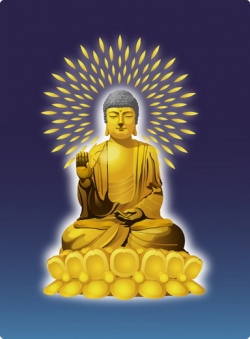The Dhyana-Samadhi Meditation Absorptions - Part 8
THE FOUR SAMADHI OF THE FORMLESS REALM
In addition to the four dhyana, we already know that there is also a more refined set of meditations called the four formless samadhi. These are also known as the four formless meditations, four formless absorptions, or four formless concentrations. As with the four dhyana, the four formless samadhi are considered "shared stages" or "common stages" on the spiritual path, although while they are called "shared" it does not mean that all people achieve them.
The entire set of eight absorptions, which includes the four dhyana, is a "shared set of attainments" within the reach of many different cultivation and religious schools. Together, the four dhyana and four samadhi make eight vehicles which are alternatively known as the eight samadhi, eight concentrations, eight absorptions, or eight jhanas.
There is a wide variety of different terms for these eight concentrations, so you must not get too confused about the matter when you encounter all the various names or descriptive substitutions which are possible. As to the ninth samadhi, which corresponds to the extinction stage of the Arhats achieved by cultivating great transcendental prajna wisdom, it is found only within the province of the Buddhist wisdom teachings because Buddhism cultivate great prajna transcendental wisdom while other schools just emphasize samadhi.
To attain this extinction stage, a practitioner must cultivate the great transcendental wisdom, and the highest stages of wisdom teachings are definitely absent in all other spiritual cultivation schools. For instance, the Vedic schools have thousands of practices, but they do not have this teaching, which explains why these schools could not produce a Buddha prior to Shakyamuni. Only with the arising of the Hindu sage Shankara, and his non-dual path, were the great wisdom teachings to obtain somewhat of a foothold in the Vedic tradition.
As indicated by their name, the four formless samadhi represent a stage of meditative attainment that no longer corresponds to the Realm of Form. Accordingly, the stage of attainment they represent surpasses the physical material world (Desire Realm) and even the energy world (Form Realm). Though there are some slight differences in the names used by various translators to signify these states, the four formless samadhi absorptions are commonly known as:
o the samadhi of infinite space (the infinite form samadhi)
o the samadhi of infinite consciousness
o the samadhi of nothingness
o the samadhi of neither thought nor no-thought
We cannot say that these four samadhi are progressively attained in the same manner of the four dhyana-which are typically mastered one after the other--and yet we could also say this as well. You might sit down to meditate and spontaneously experience the samadhi without thought and without no-thought, or the samadhi of infinite space, but you will not be able to maintain these experiential realms unless your concentration and kung-fu were stable and strong enough.
You will also recall that when you abide in a particular dhyana, the levels below you appear gross and undefined, while the levels above you appear more peaceful and refined. As we have said, this is because the lower four dhyana all refer to graduations of the Form Realm. Since the formless samadhi correspond to the Formless Realm, we cannot say that one formless samadhi is higher or lower than another. They are merely different, so you do not have to cultivate them in any particular order. Then again, you can say that they are arranged in a hierarchical ranking by order of purity.
Some schools will mistakenly tell you that the formless absorptions are attained one after the other in a progressive fashion, but this is incorrect. For instance, in the first dhyana you might also be able to reach the samadhi of infinite space even if you cannot reach the other three dhyana. As another example, in the second dhyana you might be able to reach all the formless absorptions without having attained the third or fourth dhyana. Therefore, the view of progressive attainment of the formless absorptions is incorrect. Attaining them depends entirely upon your qualifications.
We can say that the four dhyana correspond more to the aspect of our physical forms, whereas the formless absorptions have more correspondence to our psychological aspect, which is why they are "formless." Hence in one sense you can say the formless absorptions are higher than the four dhyana since the Realm of Formlessness is higher than the Realm of Form. However, in another sense you cannot say that they are higher, but only different like salt and sugar which are both used for cooking.
However you approach the issue, we have to say there are definite differences between the formless samadhi themselves in terms of the cultivation kung-fu attained, and the "object" of contemplation which is the focus of the state.
THE SAMADHI OF INFINITE SPACE
The first of the four formless samadhi is the samadhi of infinite space, also known as the samadhi of boundless space, limitless space, or infinite emptiness. Despite its name, this samadhi still resides within the domain of consciousness because you still need consciousness to know you are in it. While it is a samadhi that has broken away from the Form and Desire Realms, it is not yet a samadhi that has broken away from consciousness.
In this samadhi absorption, the appearance of forms disappears to the mind, and all thoughts of the Form Realm are eliminated because the meditator perceives everything as limitless space, without obstruction or variety. They have the perception, "this realm is infinite like space." For instance, when the Hindu adept Ashtavakra experienced this particular stage of realization, he described it by saying,
I am boundless like space; the created universe is like a jar [filled and surrounded by space). Hence, there is no [need for] relinquishing, accepting, or dissolving [the world). Such is wisdom (jnana). Where is darkness or light, where cessation? Indeed, where is anything at all for the sage who is ever immutable and untroubled? There is no heaven and no hell, not even living liberation (jivanmukti). In brief, nothing [that could be grasped by the mind presents itself] to the yogic vision.
To understand this stage of meditation, we must remember that during sitting meditation some people can occasionally reach a state where they can no longer feel their body. In this type of experience, we can say that the practitioner has temporarily forgotten the form and sensation skandhas yet without being liberated from these aggregates. They have only forgotten the skandhas because, if you analyze this event in detail, you will find that the feeling of "not having yourself" is itself still a type of knowing!
This is not to say you are not making great cultivation progress when you reach this type of experiential realm, and remain in it, but we are simply correcting the claim that this is the ultimate emptiness samadhi. Because one still has the sensation of not having a body, we know this experiential realm is not completely empty! You must remember that in order to attain the Tao you must ultimately forget everything, including the fact you are forgetting, because ultimate emptiness is even empty of the knowing of emptiness. That is why we say you must forget yourself.
How can we describe the feeling of space attained in this samadhi? When Zen master Tung-shan achieved this state, he wrote of his experience as "far away, separate from me." This stage, where he had forgotten his self, was the realm of boundless space. When Zen master Ling-yuan became enlightened upon seeing a peach blossom, he only experienced the realm of infinite space as well. But since these examples are hard for us to comprehend, there are several other examples we can employ to obtain some idea of this state (although putting forth an image of emptiness is definitely polluting the point).
The first example might be when you are riding in an airplane and you look outside to experience the space around you, which extends in every direction. Naturally, this feeling of space in the sky is quite different than the feeling of space you have when you sit within an empty room, for it is vaster and much more liberated.
Now suppose you move even farther away from the Earth's atmosphere, and into outer space, and are in that vacuous region between planets. Modern science knows there is still stuff within this void, such as virtual particles and energy streams, so it is not really empty. Nevertheless you still feel it is empty, even emptier than the sky.
The point is, in this samadhi it feels like there is a great emptiness abounding everywhere, but the samadhi of infinite space is not yet completely empty because there is still something there. What is still there? Consciousness is still there, the consciousness that knows this state.
Actually, there are seven elements that always abide within physical emptiness: the earth, water, fire, wind, and space elements as well as perception and consciousness. So we can say that empty space still contains the elements of form, including perceptions (like sound and taste), and consciousness.
In the past, people could not verify these principles using the science available at the time, but we now know that empty space does contain things that are either invisible, or so small, or so momentary that they usually go unnoticed. For instance, when you have two pieces of metal hanging in a vacuum-jar, they will be pulled together because of gravity and electrical attraction. Even if the jar has no air, you therefore cannot say the jar is entirely empty. Quantum electrodynamics tells us that even a perfect vacuum of empty space will give birth to virtual particles that are constantly born and die, so because of the advanced principles of quantum physics, you cannot say that space is empty for certain.
To better understand this samadhi of limitless space, suppose you reach a particular state of mental emptiness as if, in an analogous physical sense, you were in outer space. The stage of emptiness we are speaking of does not mean that nothing exists at all, so it is also called the "infinite form samadhi." This term may seem paradoxical, but it is to remind us that the extreme of emptiness is actually form. Thus, this name also reminds us that the space we are speaking of is still an aspect of form. It is not that one negates forms when you achieve the samadhi of limitless space, it is just that the practitioner does not take to mind the phenomena of forms.
In terms of cultivation kung-fu, when you are in this samadhi you will experience light, but not a brilliant light. If you can master this samadhi and stabilize your experience, you can be reborn into the Formless Realm at the level that corresponds to this samadhi, the Absorption of Infinite Space. How can you attain this realm? You have to cultivate the meditative absorption that views form as gross and imagines that there is only space everywhere.
In the Commentary on the Great Perfection of Wisdom Sutra, Buddha even spoke of how to practice in order to attain this samadhi. He said, "Contemplate space within the body, and always contemplate the body as being void, like an empty cage, or like a receptacle for steam cooking. (Lama Tsong Khapa said to train by imagining that the body is like an empty bag, or balloon] ... Thus, you will eventually be able to transcend form and eliminate the view of the body. As the body becomes like infinite space, so does other external form. At that time you will have succeeded in contemplating the emptiness of infinite space."
THE SAMADHI OF INFINITE CONSCIOUSNESS
All the sutras of Buddhism mention these various formless stage samadhi, but even the Esoteric school does not explain them in detail, and the descriptions in various Hindu or yoga manuals are so incomplete or misleading that these various levels are often intermixed and mistakenly taken for one another. We must note, however, that all these formless samadhi are still within the domain of consciousness, so they are all related to what Buddhism classifies as the seventh and eighth (alaya) consciousness. Only when you reach enlightenment and transform the eighth consciousness can we say you have superseded their realm.
In Zen we say that the sixth and seventh consciousnesses screen our minds from awareness of our inherent Buddha-nature, but even when you arrive at the level of the eighth consciousness, you still have to transform the basis of the alaya in order to completely attain Tao. You have to produce a revolution in its basis so that all its seeds become wisdoms, and so that its yin nature of ignorance becomes a yang nature of wisdom.
The samadhi of infinite consciousness is another of the Formless Realm absorptions and is best described as an experiential realm of boundaryless consciousness wherein everything appears to be consciousness only. In this formless samadhi absorption, you only experience undifferentiated consciousness, which is why the samadhi is called the "absorption of limitless consciousness." As in the previous samadhi of infinite space, in this state you do not take to mind any external phenomena, but only your own mind. Hence, in this state, your experiential focus can be said to represent a type of spiritual realm.
Some yogis mistake this samadhi for the ultimate stage of liberation, but the realm of only consciousness still is not the Tao. In actuality, since you are actually discriminating that there is only consciousness, you are still subject to a refined form of discrimination. Hence, emptiness is not there completely.
The realm of consciousness experienced in the samadhi of infinite consciousness is different from the eye-consciousness, ear-consciousness, nose-consciousness, tongue-consciousness, taste-consciousness and sixth consciousness of ordinary mind. In fact, in this samadhi there is no more joy and bliss, no chi, no mai, no form, no kundalini, no body and so no eyes, eye sense, object of eye, eye-consciousness and so on.
The formless samadhi of infinite consciousness is basically a scenario of infinite limitless consciousness, and since consciousness represents the existence side of Tao, we say it is a samadhi of infinite existence. However, the infinite consciousness samadhi is also a scenario of infinite emptiness because the mind expands forever to experience infinite voidness. In this state, both body and mind seem to have become absolutely void, and yet the awareness of knowing still exists. That is why we say consciousness still exists, and hence we get the samadhi of infinite consciousness.
To try and communicate this particular experiential realm, we can turn to a Sung dynasty poem, from the Confucian school, which actually paints a picture of the infinite consciousness samadhi:
The Tao is so grand it is beyond the sky and earth.
Our consciousness is so grand that all the changes
are within its realm of perception.
In the samadhi of infinite space, though we can say that space represents a certain type of emptiness, space is still a type of external phenomenon which is not inherent in our pure mental continuum. In other words, infinite space is still an object, so to rise above this realm you have to gain liberation from that condition. However, there is no such thing as space within consciousness, for the knowing of space would actually represent a transformation of consciousness into some type of thought. Therefore, space is a factor that disappears in the samadhi of infinite consciousness, and this accounts for part of the difference between these states.
The formless absorption known as the samadhi of infinite consciousness is a realm in which all thought objects have been eliminated; only mind itself exists in this realm. To rise to this realm of meditation, you have to view infinite space as gross and seek only infinite consciousness instead.
THE SAMADHI OF NOTHINGNESS
The sages tried very hard to find a better name for the samadhi of nothingness but simply could not find one. Because the name fails to accurately communicate the essence of this samadhi, sometimes the Chinese, Indians and Tibetans just refer to this absorption as the seventh samadhi, or the third formless samadhi absorption.
To find the right descriptive words for any of the formless absorptions is quite difficult because these samadhi are all far beyond the normal range of human being experience, so the seeming vagueness of this descriptive term is understandable. On the other hand, it is practically useless to simply say that one samadhi is more refined than another without any detailed explanation of their characteristics. We definitely need some sort of descriptions and characterizations in order to be able to understand these various stages of cultivation, otherwise people will always think they have reached the end objective of the spiritual path when they are still only aspirants at the beginning or in the middle of the trail. So naming these samadhi and describing them is extremely important, but in so doing we often run into this quandary of finding the proper words.
Two important questions arise when trying to describe the samadhi of nothingness: how is this samadhi different from the samadhi of infinite space, and how is it different from the samadhi of no-thought? To answer these questions, we can turn to the story of Shakyamuni Buddha, who practiced for three years to attain the samadhi of no-thought. In achieving this feat, we must remember that Shakyamuni was young, healthy and full of vitality at the time. In addition, he had incredibly great wisdom from countless lives of cultivation, and possessed the merit of a king.
From Shakyamuni's story, it is apparent that it is quite difficult to attain this samadhi, which only occurs when the mind's functioning is arrested. Because Shakyamuni discarded this realm, we also know it is not the Tao, either. Why isn't it the Tao? Because this kind of experiential realm, where you have no thoughts, is also a creation of your mind! Since it does not address the ultimate ruler of the mind, it is not the true objective of spiritual practice.
Thus, in Buddhism, the samadhi of no-thought is actually considered an outside path because you can remain in this realm for a long time without making any real progress at all towards spiritual liberation. Nevertheless, some traditions of yoga mistakenly regard this state as the ultimate. They regard it as deliverance even though once your karma for this state is exhausted you will fall out of it, and will still remain within the realm of cyclical existence.
You can say that the samadhi of no-thought is indeed a state of spiritual penetration, and yet the people who champion this state as the ultimate are confused and muddled since they do not understand the profound truth of the matter. Because of the potential for error regarding this state, the Abhidharmakosabhasya comments,
The Nobel Ones consider this samadhi a precipice and calamity, and do not value entering it. On the other hand, ordinary people [mistakenly] identify the state of no-thought (nonperception) with true deliverance, and have no idea of "going out" from it. Hence, they cultivate the absorption that leads to it.
Of course this does not mean we should look down on anyone who attains this realm of concentration (the samadhi of no-thought). Anyone who does reach this level of attainment will be rewarded with rebirth in the upper regions of the Realm of Form, which is a tremendous accomplishment. What we have to do is recognize that this still is not Tao, and is really an outside cultivation path even though it is a state of spiritual attainment.
In running after the samadhi of no-thought, as compared to the samadhi of nothingness, you are actually trying to halt your consciousness to produce a state of no-thought. Since you are using pressure or force to cover thoughts, this means you are still using consciousness as a tool in order to attain this samadhi.
We are using the term "cover thoughts" in this explanation, but this choice of words is not perfect. It is more accurate to say you are trying to "push thoughts away" so as to make it impossible for gross delusions to manifest, yet even so you still do not attain liberation from samsara when you reach this state.
Thus, the samadhi of no-thought still retains the taint of the subjective nature because getting into this stage means you are still trying to do something. Furthermore, since you are suppressing gross thoughts, feelings and discriminations, you are only temporarily avoiding the afflictions they represent without abandoning these subtle discriminations of the mind. For instance, when you fall into a deep sleep, all the mental activity of which we are normally aware ceases and it is as if we have become mindless, but when we wake up it is all there again. The samadhi of no-thought can be compared to this temporary state of sleep, because after you come out of this samadhi you are right back where you were before.
An example from history helps explain this. There was a student at the time of the third Buddha, Kasyapa Buddha, who entered a particular samadhi in order to wait for the fourth Buddha of this world, Shakyamuni. However, he stayed in this samadhi well past Shakyamuni's death, and the monk Xuan Zang found him on his way to India. When Xuan Zang found him and aroused him out of his samadhi, he informed him that Shakyamuni had come and gone, so the meditator decided to pass away to assume rebirth again. In all that time, this practitioner had managed to isolate himself from the gross afflictions of the world and remain in samadhi without his body disintegrating for thousands of years, but he had made no further progress in his cultivation attainment while thus absorbed. Hence, this type of prolonged absorption, which is a similar characteristic of the samadhi of no-thought, offers no beneficial progress towards realization at all.
Of course you should not match the description of this stage to the mistaken practice of beginners who try to freeze their minds and totally block thoughts from arising. The suppression of thought will not produce the samadhi of no-thought, but may actually produce a state of unclarity and ignorance which Tsong Khapa warned would lead to rebirth as an animal. This happens because you are suppressing the mind into a kind of forced stupidity.
Unfortunately, many meditation practitioners misunderstand the meaning of cultivation instructions and try to do exactly this. They mistakenly think they should sink their mind into oblivion through pressurized no-thinking, which is their false interpretation of "no mind." This lack of understanding is why it is hard for them to "see the truth" or "see the path."
The samadhi of nothingness, on the other hand, is superior to the samadhi of no-thought. In attaining this state, you have already reached the Formless Realm and are not suppressing consciousness. Chuang Tzu wrote about this samadhi when he wrote of the story of a gigantic fish called kun which cultivates for thousands of years and then miraculously turns into a great bird called peng (jing transforms into chi). Most people take Chuang Tzu's essays as just interesting literature, as they do with the novel The Journey to the West, and so they entirely miss their spiritual cultivation content. For instance, in this story Chuang Tzu was actually explaining the changes in the chi and mai that occur as a result of spiritual cultivation practice.
In Chuang Tzu's story, the kun bird starts flying and eventually arrives at an infinite place of nothingness; this was his description for the samadhi of nothingness. Your first thought upon initially entering this realm is "there is nothing at all," because only nothingness appears to the mind. Yet this is not the stage of real emptiness, which goes to show that emptiness must never be confused with nothingness. Anyway, this is how knowledge works: Chuang Tzu lived in China and was not privy to Buddhist or Hindu cultivation schools, and yet he came up with a similar description for this samadhi which he described through his own literary devices.
Therefore, the key is that if you are still applying some subtle effort, you are still applying consciousness to try and push away thoughts when you attain the samadhi of no-thought, but in the samadhi of nothingness, your consciousness naturally achieves this stage of emptiness. When you attain the samadhi of infinite consciousness, you have eliminated the idea of all thought objects, and you gain liberation from even that realization. You do not have any thoughts of having done something, or having attained liberation or made progress from a lower stage of attainment.
In this samadhi of nothingness, space is not an object of the absorption, and consciousness is not an object of mental absorption either. It is as if you are not taking anything to mind, and so we use the word "nothingness" for lack of better words. Here you view even consciousness as gross, and so you abide in a state of no discrimination; it is as if you attain a realm of having nothing at all.
All these high level samadhi belong to the Realm of Formlessness, and so our words are inadequate when we try to use ordinary Desire Realm language to explain and describe these scenarios. We can only hint at them using our poor literary devices, and this is the best we can do.
THE SAMADHI OF NEITHER THOUGHT NOR NO-THOUGHT
The next samadhi is the absorption of neither thought nor no-thought; this is the samadhi that Shakyamuni took three years to master under the guidance of one of his teachers, Master Aratakalama. The very name of this samadhi gives us an excellent clue as to its characteristics.
The first part of the name, "neither thought," means that this stage of samadhi is absent of ordinary mentation. It is a mental realm absent of the thinking and false thoughts of ordinary mental activity. However, the second part of the name, "nor no-thought," does not mean you do not know things and it does not mean you are not aware. It is still a stage where you are able to be aware of everything even though there is no ordinary false thought or thinking.
To better understand what this samadhi entails, we can rephrase its title as the "samadhi without thought and without no-thought." In this way, we can get the proper idea that this realm is absent of ordinary discrimination (it is a stage "without thought") but since discrimination is not totally absent, the second half of its name indicates that it is also "without no-thought."
Some people translate this stage as the samadhi of "neither perception nor nonperception," but this name tends to be misleading. Perhaps its best designation is its title as "The Peak of Cyclic Existence," for it corresponds to rebirth at the highest levels of the Formless Realm where sentient beings have incredibly long life spans with no hints of unpleasantness, and only the subtlest of mental discriminations. Nevertheless, this stage of accomplishment is still subject to the subtle afflictions of the confusions of perceptions and thoughts.
Now how can we understand this state? Shakyamuni, upon attaining this realm, asked whether in the samadhi of neither thought nor no-thought there was still a self. If you say there is a self, then it is not the stage of liberation. If you say there is not a self at this stage, then it should not be called "neither thought nor no-thought." So even though a practitioner reaching this stage can temporarily cause the coarser forms of false thought and affliction to stop, extremely subtle forms of affliction still exist in this state.
The best way to describe this samadhi is through the process of comparison, and so the first question arises, how is this samadhi different from the samadhi of infinite consciousness? The answer is, in the samadhi of infinite consciousness you still have awareness. You are still employing consciousness so you are not yet free of the factor of consciousness. However, in the samadhi without thought and without no-thought, you are not using the evaluative, discriminative functions of consciousness.
You cannot say the samadhi of neither thought nor no-thought is one of emptiness and you cannot say it is an experiential realm of existence, either. In a way, it is akin to the du-yin solitary consciousness where it seems as if the sixth consciousness is there and yet not there, active and yet not active.
There are several analogies we can use to help describe this state. It is like when you are half asleep and half awake, but neither one nor the other. It is also like when you have forgotten where you placed your keys, but you also know where they are. The Tibetan school of Esoteric Buddhism often uses the example of a fine thread to describe this state. When we look for the continuation of an extremely thin thread, sometimes we cannot find it and think it has been severed. However, if we look extremely closely, we can sometimes find the thread even though it is very fine.
Accordingly, this state seems perfectly absent of ordinary discrimination and mentation, but when we look very closely, it still exists there on an extremely subtle level. This level is so subtle, however, that it does not appear as if discrimination really exists at all. It is both there and not there, and so we have neither thought nor absence of thought. We do not have conscious thought and we do not have the state of absolute no-thought.
Another way of explaining this stage is to refer to the particulars of mandala visualization practice. Ordinary people do not normally achieve the proper level of attainment when they practice mandala visualizations, which is the samadhi of infinite consciousness. When practicing visualizations, they usually attain some stage similar to the samadhi of neither thought nor no-thought, whereas the actual goal of visualization practice is to attain the samadhi of infinite consciousness.
It is too bad that even the masters of this school do not instruct their practitioners about this sort of detail. Unfortunately, most people--and we are speaking of only those who attain some success in this type of meditative practice--only reach the level where they forget the mind and body but still retain some awareness of this fact. This is not the actual samadhi of neither thought nor no-thought, although it is similar to this state.
To try and summarize, we can say that the samadhi of limitless space focuses on the aspect of emptiness, the infinite consciousness samadhi focuses on the aspect of existence, and the samadhi of neither thought nor no-thought is somewhere between the two. It is almost as if it is half of one and half of another, which is why we can somewhat compare it to the du-yin scenario of the sixth consciousness.
When ordinary people practice visualizations, they usually feel that they forget their mind and body, yet they are also aware of this fact; their mind is not so clear but they know of this unclarity. As a result, this attainment scenario is similar to the samadhi of neither thought nor no-thought. The real attainment level of visualization practice, on the other hand, should actually be the infinite consciousness samadhi.









